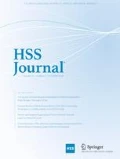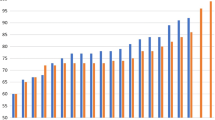Abstract
Fixation of fragility fractures with plates and screws often results in loss of fixation and need for revision surgery. Locking plates and screw were introduced to improve fixation of fragility fractures and have been in use for a decade. This review was conducted to compile evidence that locking plates and screws improve fixation of fragility fractures. A search of PubMed was performed to identify biomechanical studies as well as clinical series of fragility fractures treated with locking plates. Biomechanics papers had to use models of osteoporotic bone and had to directly compare locking plates with traditional plates. Clinical studies included case series in which locking plates were applied to elderly patients with fractures of the proximal humerus and periprosthetic distal femur fractures. Most studies are retrospective case series. Locking plates lead to greater stability and higher loads to failure than traditional plates. When applied to proximal humerus fractures, uncomplicated healing occurs in 85% of patients. Constant and Dash scores approach normal values. For distal femoral periprosthetic fractures, union rates of 75% are reported with a malunion rate of 10%. Early evidence suggests that locking plates improve results of treatment of proximal humerus fractures and distal femoral periprosthetic fractures in the elderly. Loss of fixation is associated with failure to achieve stability at the fracture site. Principles of fracture fixation in osteoporotic bone defined prior to the introduction of locking plates should still be applied.
Similar content being viewed by others
References
Alho, A.: Mineral and mechanics of bone fragility fractures. Acta Orthop Scand 1993;64:227–32.
American Academy of Orthopedic Surgeons: The Burden of Musculoskeletal Diseases in the United States. ed. Joshua Jacobs, 2008, Rosemont, Il
An Y.H., Young, F.A., Fang, Q., Williams, K.R.: Effects of Cancellous Bone Structure on Screw Pullout Strength. Univ of South Carolina Orthopedic Journal 2000; 3: 22–26
Baumgartner, M.R., Curtin, S.L., Lindskog, D.M., Keggi, J.M.: The value of the tip-apex distance in predicting failure of fixation of peritrochanteric fractures of the hip. J Bone Joint Surg Am.1995;77:1058–64.
Blatter, G., Konig, H., Janssen, M., Magerl, F.: Primary femoral shortening osteosynthesis in the management of comminuted supracondylar fractures. Arch Orthop Trauma Surg 1994; 113:134–37.
Brunner F, Sommer C, Bahrs C, Heuwinkel R, Hafner C, Rillmann P, Kohut G, Ekelund A, Muller M, Audigé L, Babst R. Open reduction and internal fixation of proximal humerus fractures using a proximal humeral locked plate: a prospective multicenter analysis. J Orthop Trauma. 2009;23:163–72
Clavert P, Adam P, Bevort A, Bonnomet F, Kempf JF. Pitfalls and complications with locking plate for proximal humerus fracture. J Shoulder Elbow Surg. 2010;19:489–94.
Cornell, C.N.: Techniques for Internal Fixation of Long Bone Fractures in Patients with Osteoporosis. J Am Acad Orthop Surg 2003; 11: 109–119
Cornell, C.N., Levine, D., Pagnani, M.J.: Internal fixation of proximal humerus fractures using the screw-tension band technique. J Orthop Trauma 1994;8:23–27.
Court-Brown CM, Cattermole H, McQueen MM.J. Impacted valgus fractures (B1.1) of the proximal humerus. The results of non-operative treatment. Bone Joint Surg Br. 2002; 84: 504–8
Court-Brown CM, Garg A, McQueen MM. The translated two-part fracture of the proximal humerus. Epidemiology and outcome in the older patient. J Bone Joint Surg Br. 2001 ; 83: 799–804.
Court-Brown CM, McQueen M. Open reduction and internal fixation of proximal humeral fractures with use of the locking proximal humerus plate. J Bone Joint Surg Am. 2009; 91: 2771
Duralde XA, Leddy LR. The results of ORIF of displaced unstable proximal humerus fractures using a locking plate. J Shoulder Elbow Surg. 2010;19: 480–8.
Egol, K.A., Koval, K.J., Zuckerman, J.D.: Current state of the art: Functional recovery following hip fracture in the elderly. J Orthop Trauma 1991; 5(3):318–24.
Egol, K.A., Kubiak, E.N., Fulkerson, E., Kummer, F.J., Koval, K.J.: Biomechanics of Locked Plates and Screws. J Orthop Trauma 2004; 18: 488–493
Ehlinger M, Adam P, Moser T, Delpin D, Bonnomet F. Type C periprosthetic fractures treated with locking plate fixation with a mean follow up of 2.5 years. Orthop Traumatol Surg Res. 2010; 96: 44–8
Einhorn, T.A.: The Structural Properties of Normal and Osteoporotic Bone. AAOS Instructional Course Lectures 2003; 52: 533–539.
Ekeland, A., Engesaeter, L.B., Langeland, N.B.: Influence of age on mechanical properties of healing fractures and intact bones in rats. Acta Orthop Scand, 1982;53:527–34.
Fankhauser, F., Boldin, C., Schippinger, G., Haunschmid, C., Szyszkowitz, R.: A New Locking Plate for Unstable Fracctures of the Proximal Humerus. Clin Orthop Relat Res 2005; 430: 176–181.
Fulkerson E, Tejwani N, Stuchin S, Egol K. Management of periprosthetic femur fractures with a first generation locking plate. Injury. 2007; 38: 965–72.
Gardner MJ, Boraiah S, Helfet DL, Lorich DG. The anterolateral acromial approach for fractures of the proximal humerus. J Orthop Trauma. 2008; 22: 132–7.
Gardner, MJ, Evans, JM, Dunbar,RP: Failure of Fracture Plate Fixation. J Am Acad Orthop Surg. 2009 Oct;17(10):647–57.
Gardner MJ, Weil Y, Barker JU, et al. The importance of medial support in locked plating of proximal humerus fractures. J Orthop Trauma 2007;21:185–91.
Gautier, E., Sommer, C.: Guidelines for the Clinical Application of the LCP. Injury 2003; 34S-B: 63–67
Hepp P, Theopold J, Voigt C, Engel T, Josten C, Lill H. The surgical approach for locking plate osteosynthesis of displaced proximal humeral fractures influences the functional outcome. J Shoulder Elbow Surg. 2008; 17: 21–8.
Herrera DA, Kregor PJ, Cole PA, Levy BA, Jönsson A, Zlowodzki M. Treatment of acute distal femur fractures above a total knee arthroplasty: systematic review of 415 cases (1981–2006). Acta Orthop. 2008; 79: 22–7.
Kim T, Ayturk UM, Haslell A, Miclau T, Pullitz CM. Fixation of osteoporotic distal fibula fractures: A biomechanical comparison of locking versus conventional plates. J Foot Ankle Surg. 2007; 46: 2–6.
Konrad G, Bayer J, Hepp P, Voigt C, Oestern H, Kääb M, Luo C, Plecko M, Wendt K, Köstler W, Südkamp N. Open reduction and internal fixation of proximal humeral fractures with use of the locking proximal humerus plate. Surgical technique. J Bone Joint Surg Am. 2010; 92 Suppl 1 Pt 1:85–95
Kristiansen, B., Christensen, S.: Plate fixation of proximal humerus fractures. Acta Orthop Scand, 1986; 57:320–23.
Large TM, Kellam JF, Bosse MJ, Sims SH, Althausen P, Masonis JL. Locked plating of supracondylar periprosthetic femur fractures. J Arthroplasty. 2008 Sep;23(6 Suppl 1):115–20.
Lill, C.A., Fluegel, A.K., Schneider, E.: Sheep model for fracture treatment in osteoporotic bone: A pilot study about different induction mechanisms. J Orthop Trauma, 2000;14:559–66.
Lucas, T.S., Einhorn, T.A.: Osteoporosis: The role of the orthopedist. J Am Acad Orthop Surg, 1993;1:48–57.
Mast, J., Jakob, R., Ganz, R. (eds): Planning and reduction technique in fracture surgery. Berlin, Germany, Springer-Verlag, 1989.
Micic ID, Kim KC, Shin DJ, Shin SJ, Kim PT, Park IH, Jeon IH. Analysis of early failure of the locking compression plate in osteoporotic proximal humerus fractures. J Orthop Sci. 2009 Sep;14(5):596–601.
Minihane, KP. Lee, C., Ahn, C., BS, , Zhang, L. Merk, BR. Comparison of Lateral Locking Plate and Antiglide Plate for Fixation of Distal Fibular Fractures in Osteoporotic Bone: A Biomechanical Study. J Orthop Trauma 2006; 20: 562–566
Nho SJ, Brophy RH, Barker JU, Cornell CN, MacGillivray JD. Innovations in the management of displaced proximal humerus fractures. J Am Acad Orthop Surg. 2007 Jan;15(1):12–26. Review
Nho SJ, Brophy RH, Barker JU, Cornell CN, MacGillivray JD. Management of proximal humeral fractures based on current literature. J Bone Joint Surg Am. 2007 Oct;89 Suppl 3:44–58.
Norrish AR, Jibri ZA, Hopgood P. The LISS plate treatment of supracondylar fractures above a total knee replacement: a case-control study. Acta Orthop Belg. 2009; 75: 642–8.
Olerud P, Ahrengart L, Söderqvist A, Saving J, Tidermark J. Quality of life and functional outcome after a 2-part proximal humeral fracture: A prospective cohort study on 50 patients treated with a locking plate. J Shoulder Elbow Surg. 2010 Mar 18. [Epub ahead of print] PMID: 20303288
Perren, S.M.: Evolution and Rationale of Locked Internal Fixator Technology: Introductory Remarks. Injury 2001; 32S-B: 3–9.
Peterson MG, Cornell CN, Paget SA, Allegrante JP. Five-Year Survival in a Cohort of Hip Fracture Patients: The Predictive Role of Pre-fracture Health Status. HSS J. 2008; 4: 43–7.
Ricchetti ET, DeMola PM, Roman D, Abboud JA. The use of precontoured humeral locking plates in the management of displaced proximal humerus fracture. J Am Acad Orthop Surg. 2009; 17: 582–90.
Ricchetti ET, Warrender WJ, Abboud JA. . Use of locking plates in the treatment of proximal humerus fractures. J Shoulder Elbow Surg. 2010;19(2 Suppl):66–75
Ricci WM, Loftus T, Cox C,Borrelli J. Locked plates combined with minimally invasive insertion technique for the treatment of periprosthetic supracondylar femur fractures above a total knee arthroplasty. J Orthop Trauma. 2006; 20: 190–6.
Röderer G, Erhardt J, Kuster M, Vegt P, Bahrs C, Kinzl L, Gebhard F. Second generation locked plating of proximal humerus fractures-A prospective multicentre observational study. Int Orthop. 2010 Apr 25. [Epub ahead of print] PMID: 20419453
Schatzker, J.: Fractures of the distal femur revisited. Clin Orthop 1998; 347:43–56
Silver, J.J., Einhorn, T.A.: Osteoporosis and aging. Clin Orthop, 1995;316:10–20
Sjostedt, A., Zetterberg, C., Hansson, T., Hult, E., Ekstrom, L.: Bone mineral content and fixation strength of femoral neck fractures. Acta Orthop Scand, 1994;65:161
Snow M, Thompson G, Turner PG. A mechanical comparison of the locking compression plate (LCP) and the low contact-dynamic compression plate (DCP) in an osteoporotic bone model. J Orthop Trauma. 2008;22:121–5.
Südkamp N, Bayer J, Hepp P, Voigt C, Oestern H, Kääb M, Luo C, Plecko M, Wendt K, Köstler W, Konrad G. Open reduction and internal fixation of proximal humeral fractures with use of the locking proximal humerus plate. Results of a prospective, multicenter, observational study. J Bone Joint Surg Am. 2009; 91: 1320–8.
Thanasas C, Kontakis G, Angoules A, Limb D, Giannoudis P. Treatment of proximal humerus fractures with locking plates: a systematic review. J Shoulder Elbow Surg. 2009; 18: 837–44.
Tinetti, M.E., Baker, D.I., Gottshall, M., et.al.: Home based multi-component rehabilitaiton program for older persons after hip fracture: A randomized trial. Arch Phys Med Rehab 1999; 80:916–22.
Xiong Y, Zhao Y, Wang Z, Du Q, Chen W, Wang A. Comparison of a new minimum contact locking plate and the limited contact dynamic compression plate in an osteoporotic fracture model. Int Orthop. 2009; 33:1415–9.
Zehnder S, Bledsoe JG, Puryor A. The effects of screw orientation in severely osteoporotic bone: a comparison with locked plating. Clin Biomech 2009 ;24: 589–94.
Author information
Authors and Affiliations
Corresponding author
Additional information
Each author certifies that he or she has no commercial associations (e.g., consultancies, stock ownership, equity interest, patent/licensing arrangements, etc.) that might pose a conflict of interest in connection with the submitted article.
Each author certifies that his or her institution waived approval for the reporting of study and that all investigations were conducted in conformity with ethical principles of research.
Level of Evidence: Theraputic Study Level IV
Rights and permissions
About this article
Cite this article
Cornell, C.N., Ayalon, O. Evidence for Success with Locking Plates for Fragility Fractures. HSS Jrnl 7, 164–169 (2011). https://doi.org/10.1007/s11420-010-9194-8
Received:
Accepted:
Published:
Issue Date:
DOI: https://doi.org/10.1007/s11420-010-9194-8




